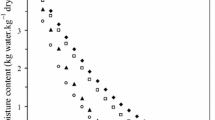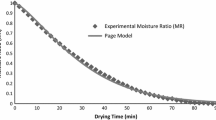Abstract
Drying kinetics of watermelon pomace was investigated in fluidized-bed and cabinet dryers using 2–6 kg/m2 tray loads at 50–70 °C. Drying behavior was described by the Page’s model with high coefficient of determination (≥0.96), lower standard error (≤0.03) and scattered residual plot. Effective moisture diffusivity of pomace during drying varied from 0.880 × 10−8 to 3.541 × 10−8 m2/s for fluidized bed and 0.347 × 10−8 to 0.868 × 10−8 m2/s for cabinet dryers. Arrhenius’s equation adequately explained the relationship between the drying rate constant/effective moisture diffusivity and drying air temperature. Lycopene content of dehydrated watermelon pomace was 11.0–17.3 mg/100 g dry basis in fluidized-bed dryer and 9.3–15.4 mg/100 g dry basis in cabinet dryer.
Access this article
We’re sorry, something doesn't seem to be working properly.
Please try refreshing the page. If that doesn't work, please contact support so we can address the problem.


Similar content being viewed by others
References
Akpinar EK, Toraman S (2013) Estimation of the moisture diffusivity and activation energy in thin layer drying of ginger slices. World Acad Sci Eng Technol 78:1308–1311
Arocho YD, Bellmer D, Maness N, Mcglynn W, Patricia RD (2012) Watermelon pomace composition and the effect of drying and storage on lycopene content and color. J Food Qual 35:331–340
Chawla C, Kaur D, Oberoi DPS, Sogi DS (2008) Drying characteristics, sorption isotherms and lycopene retention of tomato pulp. Dry Technol 26(10):1257–1264
Crandall PG, Kesterson JW (1981) Components of processed watermelon fruit. J Am Soc Hortic Sci 106:493–495
Crank J (1975) The mathematics of diffusion. Claredon Press, Oxford
Doymaz I, Gorel O, Akgun NA (2004) Drying characteristics of the solid by-product of olive oil extraction. Biosyst Eng 88:213–219
Falade KO, Igbeka JC, Ayanwuyi FA (2007) Kinetics of mass transfer and color changes during osmotic dehydration of watermelon. J Food Eng 80:979–985
FAO (2014) Food and Agriculture Organisation of United Nation. http://faostat.fao.org/site/567/default.aspx#ancor. Assessed Dec 2014
Hayoglu IA, Fenercioglu H (1990) A research on the possibility of using watermelon juice in fruit juice industry. Gida 15:329–332
Kang B, Zhao W, Hou Y, Tian P (2010) Expression of carotenogenic genes during development and ripening of watermelon fruit. Sci Hortic 124:368–375
Kaur D, Wani AA, Sogi DS, Shivhare US (2006) Sorption isotherm and drying characteristics of tomato peel isolated from tomato pomace. Dry Technol 24:1–6
Kerje T, Grum M (2003) The origin of watermelon (Cucumis melo): a review of the literature. www.vitacost.com
Koua BK, Koffi PME, Fassinou FW, Andoh HY, Gbaha P, Tourpak P (2013) Evaluation of some thin layer drying models and effective moisture diffusivity of yam (Dioscorea rotundata) slices. Pak J Food Sci 23(1):1–9
Perkins-Veazie P, Collins JK (2006) Carotenoid changes of intact watermelons after storage. J Agric Food Chem 54:5868–5874
Perkins-Veazie P, Collins JK, Davis AR, Roberts W (2006) Carotenoid content of 50 watermelon cultivars. J Agric Food Chem 54:2593–2597
Pinto MP, Santos CN, Henriquesa C, Lima G, Quedas F (2011) Lycopene content and antioxidant capacity of Portuguese watermelon fruits. Electron J Environ Agric Food Chem 10(4):2090–2097
Purkayastha MD, Nath A, Deka BC, Mahanta CL (2011) Thin Layer drying of tomato slices. J Food Sci Technol 50:654–654
Sadler G, David J, Dezman D (1990) Rapid extraction of lycopene and β- carotene from reconstituted tomato paste. J Food Sci 55:1460–1461
Shi J, Maguer ML, Bryan M, Kakuda Y (2002) Kinetics of lycopene degradation in tomato puree by heat and light irradiation. J Food Proc Eng 25:485–498
Shin DH, Koo YJ, Kim CO, Min BY, Suh KB (1978) Studies on the production of watermelon and cantaloupe melon juice. Korean J Food Sci Technol 10:215–218
Shivhare US, Arora S, Ahmed J, Raghavan GSV (2004) Moisture adsorption isotherms for mushrooms. LWT Food Sci Technol 37:133–137
Sies H, Stahl W (1998) Lycopene: antioxidant and biological effects and its bioavalibility in the human. Proc Soc Exp Biol Med 218:121–124
Sinija VR, Mishra HN (2009) Thin-layer modeling for drying of pressed tea leaf residue to produce green tea. J Food Sci Technol 46(6):515–524
Sogi DS (2003) Effect of concentration and temperature on viscosity of watermelon juice. J Food Sci Technol 40(5):509–511
Sogi DS, Bawa AS (1998) Dehydration of tomato processing waste. Ind Food Packer 52:26–29
Sogi DS, Shivhare US, Garg SK, Bawa AS (2003) Water sorption isotherm and drying characteristics of tomato seeds. Biosyst Eng 84(3):297–301
Uddin MB, Nanjudaswamy AM (1982) Studies on the processing of watermelon for juice. Bangladesh J Sci Ind Res 17:80–86
Author information
Authors and Affiliations
Corresponding author
Additional information
Highlights
• Watermelon pomace is generated during processing of watermelon.
• It is generally discarded as waste leading to environment problems.
• Watermelon pomace contains more lycopene as compared to its flesh.
• Dehydration can increase the shelf life of pomace.
• Pigment extracted can be used in different food products.
Rights and permissions
About this article
Cite this article
Oberoi, D.P.S., Sogi, D.S. Drying kinetics, moisture diffusivity and lycopene retention of watermelon pomace in different dryers. J Food Sci Technol 52, 7377–7384 (2015). https://doi.org/10.1007/s13197-015-1863-7
Revised:
Accepted:
Published:
Issue Date:
DOI: https://doi.org/10.1007/s13197-015-1863-7




